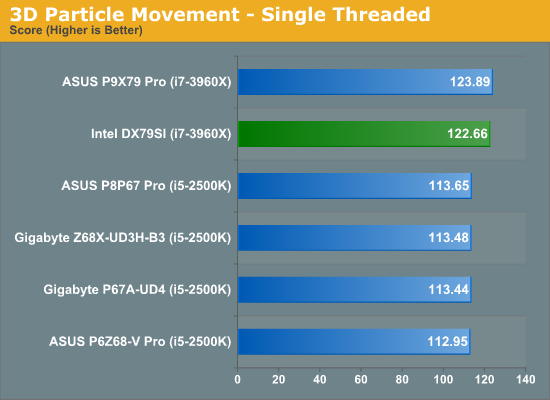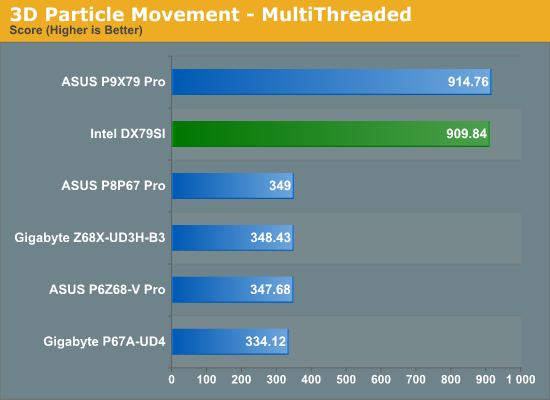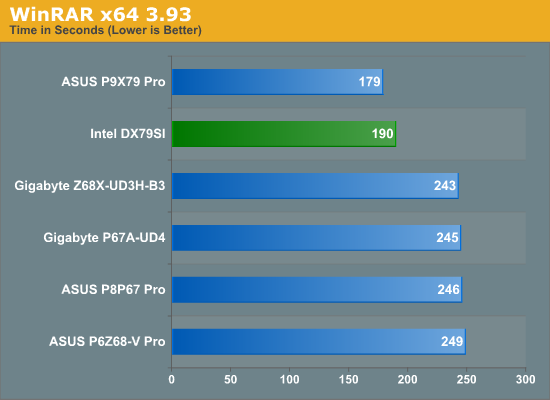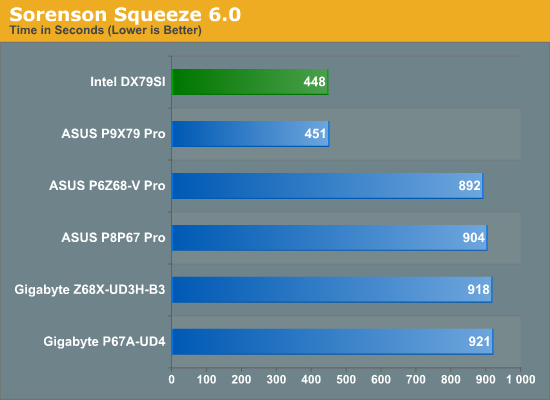Intel DX79SI Review: The Default X79?
by Ian Cutress on November 18, 2011 1:10 AM EST- Posted in
- Motherboards
- Intel
- X79
3D Movement Algorithm Test
The algorithms in 3DPM employ both uniform random number generation or normal distribution random number generation, and vary in various amounts of trigonometric operations, conditional statements, generation and rejection, fused operations, etc. The benchmark runs through six algorithms for a specified number of particles and steps, and calculates the speed of each algorithm, then sums them all for a final score. This is an example of a real world situation that a computational scientist may find themselves in, rather than a pure synthetic benchmark. The benchmark is also parallel between particles simulated, and we test the single thread performance as well as the multi-threaded performance.


As we saw with the ASUS board, the 3960X with its higher multiplier in ST and 12 threads in MT dominates our 3DPM results. However, the DX79SI does come in lower than the P9X79 Pro on both accounts.
WinRAR x64 3.93 - link
With 64-bit WinRAR, we compress the set of files used in the USB speed tests. WinRAR x64 3.93 attempts to use multithreading when possible.

Given the regularity within previous chipsets on our WinRaR test, it is perhaps surprising that the DX79SI performs a whole 11 seconds slower than the P9X79 Pro. Despite this, the results were repeatable, indicating that the boards detect differently how many CPUs are running and turbo core appropriately.
FastStone Image Viewer 4.2 - link
FastStone Image Viewer is a free piece of software I have been using for quite a few years now. It allows quick viewing of flat images, as well as resizing, changing color depth, adding simple text or simple filters. It also has a bulk image conversion tool, which we use here. The software currently operates only in single-thread mode, which should change in later versions of the software. For this test, we convert a series of 170 files, of various resolutions, dimensions and types (of a total size of 163MB), all to the .gif format of 640x480 dimensions.

As noted in previous X79 testing, FastStone seems not to benefit from the faster LGA2011 CPU, and nothing separates the X79 boards.
Sorenson Squeeze 6.0 - link
Sorenson Squeeze is a professional video encoder, complete with a vast array of options. For this test, we convert 32 HD videos, each a minute long and approximately 42 MB in size, to WMV 512KBps format. Squeeze can encode multiple videos at once, one for each thread.

As our Squeeze test uses all the threads all the time (unlike WinRar), we see a relatively small difference in the results here.










60 Comments
View All Comments
Blaze-Senpai - Friday, November 18, 2011 - link
I always thought Intel made their boards as a "reference" like Nvidia makes "Reference" cards; great if you want a basic but reliable board that doesn't have 9001 features you can mess with and set something on fire with at least.As for All Intel Branding... if only Intel made RAM...
Bristecom - Saturday, November 19, 2011 - link
Wow, the price of motherboards has really gone up. My top of the line Intel mobo from 2004 (D875PBZ) and my brother's top of the line Intel mobo from 2008 (DX48BT2) were only about $150; now they're double!BTW, I'm kind of surprised you didn't mention the audio here. But I guess nobody cares about onboard audio anymore since they're all basically the same Realtek codec?
Anyway, thanks for the review AnandTech, you always have the best reviews on the net!
Bristecom - Saturday, November 19, 2011 - link
Guys, I just had a look at Intel's Product Brief on this motherboard here: http://www.intel.com/content/dam/doc/product-brief...It says UV Reactive SATA Cables ARE included! Also, strangely, it lists under "Hardware Management Features" that it has "Processor Fan Speed Control" and "System Chassis Fan Speed Control!" AND it lists PCI Express 3.0 for all three ports! So if these specs are indeed correct, this review needs to be updated. Perhaps the reviewer got a crappy pre-release model/prototype?
rallyhard - Saturday, November 19, 2011 - link
Don't mean to be rude, but I expect a little more out of AT than:"However, to an enthusiast, it is strange to say that they sell well "
"While ASUS, Gigabyte, MSI and the test have teams of designers for graphical interfaces"
"I can much use for this in case errors arrive"
"A lot of motherboard manufacturers in X79 should be placing the first and second PCIe slots at least an extra PCIe width apart"
"There is a big gap in the I/O"
...and that was only on the first page.
Are other commenters just holding their tongues to be nice, or...?
marraco - Sunday, November 20, 2011 - link
-I love how small those chips are getting. Each year they appear more and more like if they were printed on the PCB.-They should put the first PCI slot nearest to the processor, because is the only one place which can be used to plug video cards without being blocked.
That would need extra space on the case for the last video card, if it takes 2 slots, but most cases have that extra space, so I think that blocking a potential PCI slot is worse that blocking a potential third card.
You do not want to put a triple video card system on a small case, because of airflow and cooling constrains. But if you spend all that money, is more probably that you also will invest on other cards, like decent sound.
-As ever, Intel motherboards are crappy and expensive.
Questor - Sunday, November 20, 2011 - link
While I agree, dual LAN without teaming seems a bit silly at this point in history and missing other bells and whistles (new BIOS type) at it's price point is a bit disappointing. However, unless I read this review cross-eyed (trust me, I have sleep problems, it's possible), this Intel board performs better than most of the 3rd party manufacturers who have much bigger groups working on developing their bread and butter products. Slot placement has seemingly always been a gripe by consumers from every board maker at various releases and certainly not an exclusive to an Intel board. I am not defending it, I am just saying, I have seen (maybe not here) board become recommended even though slot placement was a con many times.Maybe I am missing something here, but when a board is rock solid reliable, overclocks decently (if that is a feature a customer wants), and out-performs and/or is on par with 3rd party board performance at or near the same price point, isn't that a win?
I have never owned an Intel board in my life. If I read around the 'Net and see similiar performance comparisons, this could be my first.
soltys - Monday, November 21, 2011 - link
While I agree with some points, 2 things i'd like to point out:- looking at the /relatively/ slim and non-bloated software controls - they are already a reason for some award ('common sense' one perhaps ?). Relatively to the bloat other companies can stuff ... one often avoids using them because they are essentially a few checkboxs / sliders weighting heavy tens or hundreds (CCC, *cough*) megabytes; leaving aside well guessed reasons
- subjectively, I've always considered a front panel with knobs as a proper method to control fans, not a software
ReySys - Tuesday, November 22, 2011 - link
I always use this motherboards. In last times I was hoping to try a Asus. But Intel MB are very stable. The warranties are excellent. Fail is a rarity in this motherboards. I agree is rare to see a review. In the weekend, I see the 2 new enthusiast boards & I correct my decision to try Asus. What I like of this brand is they always are in emergent markets as Mexico. For so many years. You can try his technology. Asus in the other side only bring the cheap models. Maybe a disttributor in a rare ocasion brings a premium model. The price is high but is worth it. My desktops rigs endure almost 2 or 3 years with me. Then I resell the rig and my clients fight for it. They keep the anothar 2-3 years. The value of a self made desktop is very high. First his performance is better than any standard desktop, so you only need to change it when is leap forward in technology. The resell value is high too. In self-made you can always change a part to improve performance. This is the reason why I don´t like iMacs, so closed mind devices. I you feel the power, you are a hard to eclipse person. I always tell my boss that bringing my self-made equipment becasue his Enterprise Hp desktops are a shame. The idea is if you follow company guidelines you are going to be very behind of reality & speed. Have a nice week!bellends - Saturday, January 4, 2014 - link
This mobo DOES support teaming. WTF dudeRodofhot - Tuesday, September 2, 2014 - link
They prob dont even know what teaming is they are just repeating some early reviews they read.There r two kinds of people ones who like Intel everything and they seem to remember the pros of an intel board and thoes who want a cheap alternative to an intel mb and they seem to recall any cons of an intel board even though those cons may be a farse. I've read this mb doesn't support PCI 3.0 and also that it does support it in this articles' comments. Notice the guy who states PCI 3.0 is supported includes a link. Like me he must be the type who remembers the pros I guess as a fan of intel I must go uncover the truth. My guess is maybe a relase bios left ver 3.0 unsupported as with the teaming.